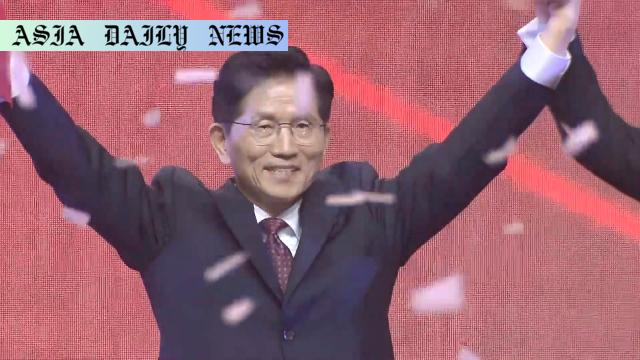Presidential Candidacy – South Korea’s ruling People Power Party reinstates Kim Moon-soo as their presidential candidate post vote.

Internal Party Dynamics Lead to Sudden Changes
The political landscape in South Korea witnessed a whirlwind of events as the ruling People Power Party (PPP) reversed its decision to remove its earlier presidential nominee, Kim Moon-soo, within a matter of hours. The initial move to revoke Kim’s candidacy came from calls within the PPP leadership to align behind a unified candidate capable of presenting stronger competition to opposition frontrunner, Lee Jae-myung, of the Democratic Party. However, dissent among party members led to an all-party vote on Saturday, which rejected the re-selection process.
The pressures within the ruling coalition arose from dwindling internal morale and the rising strength of Lee Jae-myung in pre-election opinion polls. This prompted a faction of party members to consider former Prime Minister Han Duck-soo as a stronger candidate to challenge the opposition. Interestingly, Han, who had announced his candidacy as an independent, presented himself as an alternative centerpiece for unity. Despite these efforts, the PPP ultimately reinstated Kim Moon-soo post the democratic rejection of the re-selection mechanism.
Strategic Implications for the Ruling Party
This reversal has significant implications for South Korea’s ruling party as it gears up for the June 3 presidential election. Kim Moon-soo’s reinstatement underlines both the challenges of maintaining intra-party cohesion and the stakes of devising an effective strategy to compete with the opposition. Furthermore, this development reflects a broader dilemma—whether political parties should prioritize unity over reshuffling candidates to maximize electoral outcomes.
Kim, a former Employment and Labor Minister, now faces the challenge of rallying both the party’s support and public trust amidst this controversy. While Lee Jae-myung of the Democratic Party maintains high opinion polls, the PPP’s ability to present a comprehensive policy plan and a unified front will likely determine the election’s outcome. By readjusting their campaign efforts around Kim’s candidacy, the PPP has taken a calculated risk aiming for electoral coherence versus internal upheaval.
Looking Forward: The Political Stakes
The rapid reinstation of Kim Moon-soo illustrates the volatility of South Korea’s political climate, with major parties trying to stabilize their positions amidst pressing challenges. For voters, such shifts may highlight perceived disarray within the leadership—potentially influencing their confidence in governance. Still, Kim’s potential to galvanize support will depend heavily on his ability to articulate compelling policy stances and address public concerns.
Simultaneously, the decision to revert to Kim underscores an existential dilemma for political parties navigating leadership disputes. With South Korea’s presidential election just weeks away, the PPP faces daunting choices, from solidifying party unity to presenting a robust vision for the country’s future. While opposition leader Lee Jae-myung and New Reform Party’s Lee Jun-seok have already registered for the election, Kim Moon-soo is expected to formalize his candidacy by Sunday morning, further intensifying the contest ahead.
Commentary
A Sudden Reinstatement Reflecting Political Pressures
South Korea’s political scene was thrown into disarray with the People Power Party’s rapid decision to reinstate Kim Moon-soo as their presidential candidate shortly after an attempt to reselect a new nominee. This chain of events highlights the immense pressure political parties face when attempting to balance internal dynamics, public perception, and electoral strategy. It is a vivid example of how quickly party leadership can reverse its course under collective dissent.
Kim’s reinstatement appears to be a decision grounded in the immediate necessity of demonstrating unity ahead of the June elections. With opinion polls showcasing opposition candidate Lee Jae-myung surging ahead, the PPP seemed compelled to reestablish coherence and avoid the fractures that a further delay in solidifying its candidate could have brought. Yet, one cannot overlook the optics of such sudden changes; to many voters, this could signal a lack of preparedness or decisiveness within the ruling party.
The Risks and Rewards of Cohesive Decision-Making
While the decision to reinstate Kim eliminates short-term uncertainty, it also places an immense burden on his shoulders to perform amidst a highly competitive election. Political candidates often embody their party’s preparedness; as such, Kim must now work tirelessly to rebuild momentum, both within the PPP and in engaging the wider electorate. The balancing act of addressing internal party priorities, while crafting a vision for South Korea’s future, will be crucial.
This moment is also a testament to the challenges of managing modern political campaigns. As South Korea’s elections draw nearer, all eyes will closely watch how the PPP navigates the aftermath of this turbulent episode. What remains clear is that political unity—although difficult to achieve—has become even more vital for parties seeking electoral success in today’s high-stakes political environment.


